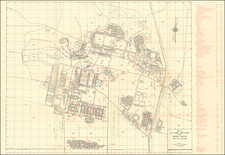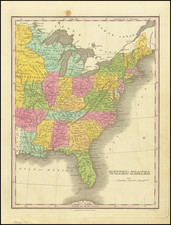The Rocket Race, published in The American Weekly on March 5, 1961, offers a visual and analytical representation of the Cold War's missile competition between the United States and the Soviet Union. Distinguished by its color-coding, the map pinpoints the key launching sites, missile and engine development centers, testing areas, and missile and rocket plants or schools in Russia, while detailing the offensive missile bases, testing and development centers, and missile training areas of the United States. Accompanying these geographical markers are annotations denoting the specific missile types and their intended uses, illustrating a meticulous inventory of the arsenal amassed by both superpowers.
The map's backdrop is the geopolitical stage of the early 1960s, an era marked by escalating tensions between the USA and the USSR, with each vying for global supremacy in technology, ideology, and military prowess. The period, which bore witness to the Cuban Missile Crisis and the Space Race, was characterized by a strategic buildup of missile arsenals and advanced technologies. The presence of the Soviet T-4 intercontinental ballistic missile, as indicated in the schematic illustrations, with its expansive range, emphasized the daunting capabilities of the USSR, challenging the geopolitical equilibrium.
Brigadier General David Sarnoff's accompanying text, placed alongside the cartographic representation, offers an American perspective on the perceived missile gap. As the Chairman of the Board of the Radio Corporation of America, Sarnoff argues against the notion of a solely technical lag, suggesting that any disparity is more political in nature. His commentary engages with the pervasive anxiety of the time, urging Americans not to view their position as inherently inferior based solely on missile counts.
The detailed depictions of missiles such as the Redstone and Minuteman underscore milestones in American missile technology. The former, having recently sent a chimpanzee into space, and the latter, touted as the first rocket powered by solid fuel to achieve an impressive range, emphasize America's advancements and achievements in rocketry and space exploration.
In summary, The Rocket Race serves as a multifaceted artifact from the height of the Cold War, offering a meticulous depiction of the missile capabilities of both superpowers. Through its visuals and textual components, the piece presents a comprehensive insight into the arms race, reflecting the anxieties, aspirations, and advancements of a world on the brink.
The American Weekly
The American Weekly was a magazine supplement that was included with the Sunday edition of the Hearst newspaper chain, which had papers across the United States. The main office of The American Weekly was in New York City, so while it was distributed nationwide via Hearst newspapers, it can be said that it was published out of New York.











![[Whoever is silent is Complicit -- Anti-Vietnam / Anti-American Poster] Vietnam: Sterminio | chi tace è complice](https://storage.googleapis.com/raremaps/img/small/89365.jpg)

![(Anti-Nato Propaganda) Военные Блоки-Оплот Милитаризма [Military Blocs-Strongholds of Imperialism]](https://storage.googleapis.com/raremaps/img/small/94274.jpg)
![Sarmatia Utraque Europaea et Asiatica [Ancient Russia from both Europe and Asia]](https://storage.googleapis.com/raremaps/img/small/82027.jpg)

![[Unusual Italian Immigrant Communities shown!] America Settentrionale, Centrale e Meridionale -- Carta Dimostrativa Delle Ambasciate, Legazioni, Consolati (Con Le Risettive Circoscrizioni Territoriali), Camere Di Commercio, Agenzie Commerciali, Stazion Enotecniche, Uffici Postali, Ospedali, Scuole Governative e Sussidiate All'Estero](https://storage.googleapis.com/raremaps/img/small/86098.jpg)